Loved ones who are grieving may ultimately make different decisions

Funerals, shivas, memorials and other rites that mark a death are a fact of life. They bring together people to mark the deceased’s life and passing, while providing comfort, support and a sense of community. But more and more, people are opting not to have a traditional service or rite, choosing something different or even nothing at all. Those left behind after a death may have strong feelings about those wishes, especially if the instructions run counter to their own ideas and beliefs.
“I think it’s important to honor the person who has died and their wishes,” said Candi Cann, an associate professor of religion at Baylor University in Waco, Texas. “But I also think it’s important to honor the needs of the person who is left behind, and sometimes those [wishes and needs] don’t always match up.”
“Everybody has different ways they want to remember the people they love.”
The important thing is those who are left behind get the support they need, so there must be a conversation that lays this all out before someone dies, she said.
Talking about death and dying in the past was natural because it was so common, even among children. This changed as medicine began to improve in the 1900s and death became a more sensitive topic as doctors did everything they could to keep their patients alive. Death was considered a failure and it became a subject that wasn’t openly discussed among family and friends. But we need to start talking about it again so everyone is on the same page, without assumptions and, hopefully, without bad feelings, Cann added.
No Funeral Please
Kelly Erb, a lawyer in Pennsylvania, has had this conversation with her husband and children more than once. Being part of a large family exposed Erb to death from a young age.
“I grew up in the rural south and it’s very community-oriented, and also very community-oriented around churches,” she explained. “So if someone in the church were to die, for example, it was expected that you would go to the funeral.”
One of Erb’s first funerals was for a girl who was about 14 years old when she died in a car accident and it left a strong impression because the girl in the open casket didn’t look at all like the girl Erb knew when she was alive.
Later, Erb began her career as an estate attorney, advising clients on end-of-life issues. These personal and professional experiences all had an impact on her. She decided that she would not have a funeral. A party is fine, she said, but not a funeral.
“I’ve joked about that with my kids. I want them to play ‘My Way,’ and it has to be the Elvis version,” she said. “We’re usually talking about death in that way. I feel like so many times, with respect to these services, we have one idea of what should happen. And everybody grieves differently. Everybody has different ways they want to remember the people they love. I wouldn’t want anybody to tell [my kids] how they have to remember me or how they have to mourn me. And if that is them sitting around and watching a movie that I really, really liked, they can do that.”
Honoring a Loved One’s Wishes
Laurie (a pseudonym) lost her husband unexpectedly earlier this year. He didn’t want a funeral either. So when he died, Laurie felt she needed to respect his wishes but she admitted this left her feeling isolated as she mourned. Laurie said that had she done the traditional Jewish funeral and shiva, a period of seven days when people visit, bring food, and provide support, she may not have felt so alone. But she did manage to find support in other ways.
Complete Article ↪HERE↩!
Don’t Forget the Death Workers
Hayley Campbell on the hidden labor after life

Anglo-American attitudes toward burial have changed significantly over the past half century: today, most people choose to be cremated, and alternatives like natural burials and human composting are on the rise. Margareta Magnusson’s The Gentle Art of Swedish Death Cleaning, about the importance of getting your affairs in order, was a surprise bestseller, and American mortician Caitlin Doughty is but one of several popular YouTube personalities who speak about death. But largely absent from the conversations at so-called Death Cafes (coffee, crumpets, and the inevitable!) is any discussion of the people who devote their lives to caring for the dead. These death workers are the focus of Hayley Campbell’s new book, All the Living and the Dead. Campbell speaks to people doing jobs we tend not to consider: embalmers and executioners, of course, but also crime scene cleaners, mass fatality investigators, bereavement midwives, and others. What makes these people choose to surround themselves with death tells us a lot about what the rest of us lose when we relegate death to the shadows.
Complete Article ↪HERE↩!
How to Write an Obituary
A Guide to Crafting a Meaningful Memorial
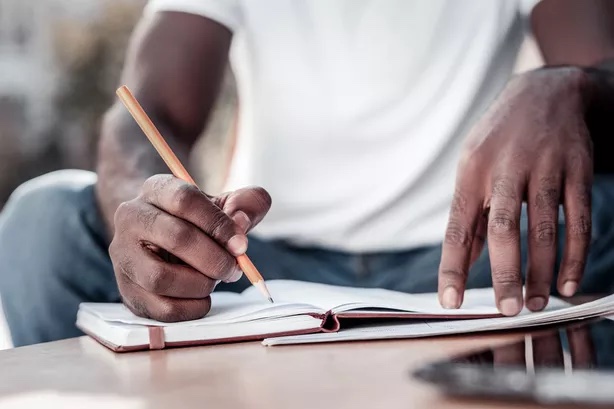
When you write an obituary, it’s so that you can announce the news that a loved one has died. Family, friends, former colleagues, and the community will want to know details about the viewing, memorial service, or funeral, and any plans for a burial.
You also may wish to add a summary that personalizes the life and legacy of your loved one, and acknowledges the surviving family members. In some cases, a cause of death and preference for any donations to a health-related or community organization may be included.
This article offers ideas on how to honor a loved one or even write an obituary for yourself ahead of time. Even if you’ve never written an “obit” before, you’ll learn how by following a step-by-step approach.
Planning the Obituary
As you plan your loved one’s obituary (or your own), first check with the funeral home or similar service that’s handling end-of-life arrangements.
These agencies will often help people who need to write an obituary. They may have a guide for obituary writing that’s part of a planning overview. They also may have an online platform where you can place a digital obituary, and invite people to share memories, images, and video.
Some are free, so check with the service provider. With newspapers, call ahead to check on the rates. Expect a charge of $200 to $500 for a “short” obit (often up to 300 words) and up to $1,000 for a “long” one with a photo.
That way, you’ll know how to plan the length of the obituary ahead of time, or make adjustments that align with your loved one’s and family wishes in the space that you’ll have.1
Writing an Obituary, Step by Step
First, you’ll want to collect the information you need. You also can decide on a family member or friend who will help in the process of writing an obituary.
It may help to ask people who knew your loved one from teams, clubs, or faith-based and community groups to contribute information, alongside those who may have worked with them.
Select your preferred tool, whether you’re writing with pen and paper or on a computer. Many people will want to use a template for an obituary that’s easy to use in digital form, but you can follow this step-by-step approach on paper too.
Basic Obituary Facts
An obituary needs to include key details about your loved one. These basic facts include:
- The full name of the deceased
- Their age
- Where the deceased lived
- Their date and place of birth
- The date and place of death
- The date and cause of death (which the family may wish to withhold)
You’ll start with a basic announcement of the death that clearly states your loved one (name, age, hometown) died. You might add that the death was suddenly, or expected after a long illness, with the time and place of death.
The place can be specific or, if you prefer, you might simply say they were surrounded by family.
Summary of Life
When writing an obituary, you’ll want to include a brief summary of the deceased’s life. This is a way to honor them and the meaning their life held, but also to help other people remember them.
You can be straightforward, moving from one fact to another. You can be more heartfelt, or even humorous. You also may already know what your loved one wanted to include and plan to stay faithful to their ideas.
There really is no “right way” to write an obituary. But most obituaries will next include the person’s birth information, including the place and their parents. It’s common to include their job and career information, if it applies. You may want to add any educational achievements.
A detail or two about their community activities, favorite hobbies, or their faith-community membership would be included here, too. Choose the things that reflect the identity of your loved one and how their life was shared with family and friends.
It’s better to gather “too much” information early on. You can always edit and/or shorten your obituary later.
Family Names in an Obituary
An obituary also focuses on family, both those who died before your loved one and the survivors who are honoring your loss. So you’ll include both living and deceased family members.
If you’ve included the full names of the deceased’s parents earlier, you don’t need to repeat them here. What you’ll want to do is describe the family members in order of the closest relationships.
A spouse or partner, and any children, are typically listed first. The spouses or partners of children also are listed but set off with parenthesis so that it looks like Child (Partner’s First Name). Then siblings, also listed with their partners if preferred
Any grandparents, aunts, uncles, step-family members, or cherished and special friends should be included. Be sure to write the total number of grandchildren or great-grandchildren, even if you do list them by name.
It’s not unusual for people who died before your loved one to be listed separately. A “preceding them in death” paragraph can include those who have not already been mentioned.
Funeral or Memorial Details
An obituary is meant to share details about any funeral and memorial services. If you plan to invite the public, be clear that this is the case. If your ceremony is private, be clear about that, too.
For a public memorial, simply invite “family and friends” to the service. When you write the obituary, make sure people have information that includes:
- Time
- Day
- Date
- Place
- Location
Be sure to include any other information that may be helpful to those attending the service. That includes the name of the funeral home, and any memorial website to honor your loved one’s life.
Donations
It’s common to ask people who might otherwise have sent flowers or a gift to make a donation instead. There’s a good chance that your loved one may have already told you their wishes about donations to a charity or memorial fund.
If not, then the choice is up to the family. Just be sure to name the charity or memorial fund to which donations should be sent. An address helps, too.
Checking the Facts
Obituaries are more than a matter of public record. They can become lifelong keepsakes for the people left behind. You’ll want to be sure it’s right, both now and in the future.
You can work with another family member or a friend to proofread your obituary writing and make sure all the facts are correct and that no one was missed in the family list.
Be sure that the spellings of names and places are right. That’s especially important if titles like “Dr.” or abbreviations like “Jr.” are needed to differentiate between people.< Sometimes, the ears are better than the eyes when it comes to improving the tone of a story. So, always give it one last read aloud, so that you can "hear" the tone, the facts, and any changes you'll want to make before publishing it.
Proofreading Tip
Edit the obit first, then proofread it. Editing involves revising, reorganizing, and rewriting sentences for clarity. Proofreading is checking details like spelling and punctuation. You’re bound to catch more when you focus on one task at a time.
Summary
Structuring an obituary is largely a matter of choice; no two are alike. But readers expect to learn some generic information about the deceased, including basic facts, a life summary, list of relatives, and details about the final service.
Before you get too carried away with writing, check current rates that newspaper and online platforms charge to run an obit. The difference in price may influence your preferred word count.
Frequently Asked Questions
- What should be included in an obituary?
- The full name of the deceased, including nicknames
- The age of the deceased at the time of death
- The city or town of residence at the time of death
- A list of immediate surviving family members
- A brief summary of the deceased’s life
- Memorial or funeral details with the address and date
- Details about charities or memorial funds to send a donation
- Should the cause of death be in a obituary?
Check with the deceased’s spouse or family members before publishing the cause of death. In some cases, the family may prefer to keep this detail private. In such cases, you can use a euphemism like “passed after a long illness” or “passed suddenly.” Or you can sidestep the subject entirely and not mention it at all. - What should be excluded from an obituary?
Obituaries should not be written in the first person. This means you should not use the word “I”. Remember that an obituary is not a personal tribute. You should also exclude personal addresses and phone numbers.Complete Article ↪HERE↩!
An obituary should be informative. Be sure to include:
Ashes to Ashes
Turning the dead into soil in Washington State.

Micah Truman, founder of Return Home, uses the word beautiful many times during our conversation about his company’s unique burial process.
Terramation—what Return Home calls human composting—a two-month-long process that turns deceased bodies into soil, is new to the world. So new, in fact, that the service is offered in only a few places on the entire planet, and Washington State happens to be one.
Washington became the first place in the world to legalize human composting, thanks to a small, dedicated group of funeral directors led by Katrina Spade, a founder of the nonprofit Urban Death Project. As an undergrad at the University of Massachusetts Amherst, Spade had received the prestigious Echoing Green Fellowship and worked with scientists and biologists to develop a process that turns human remains into soil. In 2018, Spade pushed for human-composting legislation in Washington, later signed by Governor Jay Inslee in 2019. After it became law, she opened the world’s first human-composting center, Recompose, located in Seattle.
This content is imported from YouTube. You may be able to find the same content in another format, or you may be able to find more information, at their web site.
Currently, there are only three states that provide this service: Washington, Colorado, and Oregon. Other states, including California, are working on similar legislation. In 2021, California Democratic assembly member Cristina Garcia, from Bell Gardens, introduced Assembly Bill 501, which would legalize “natural organic reduction.” It successfully passed out of the California State Assembly, the Senate Health Committee, and the Senate Business and Professions Committee, but it is currently tabled.
Return Home is located in Auburn, a suburb 20 miles south of Seattle. Speaking with me on a sunny spring morning, Truman recalls the story of a California family who recently used Return Home’s service.
The woman’s son had died suddenly, and she’d decided that because he hadn’t liked to fly when he was alive, she would transport him in a car herself. She drove from Northern California to Washington, her son’s body cooled and packed according to Return Home’s instructions. Once she arrived, Truman recalls, “She was able to sit with him and talk with him. We were able to place him in his vessel with his mom there.”
“It was one of the most beautiful things I’ve ever seen,” Truman says.
An entrepreneur and investor, Truman saw the Washington legislation as not just a business opportunity but an environmental one. The funeral industry isn’t particularly innovative: most people opt for either burial or cremation, and neither of those are good for the planet, he explains.
“Cremation has long been considered the environmental alternative. It’s the one that people use. It’s what I would have used, or my family, because we consider it the least environmentally impactful,” he says.
But, he points out, “Cremation uses about 30 gallons of fuel, spews about 540 pounds of CO2 into the air per cremation.”
The burial service Truman offers is different from a green burial, which, at its simplest, involves placing an unembalmed body directly into the ground without a box. Though green burial is also more natural than cremation, it presents the same problem that traditional cemeteries often face: limited space.
The idea of human composting might seem weird at first. Some “conservative religious groups” have reservations, says Truman, but he points out that the Catholic church was also once averse to cremation and is now on board. And if you think of human composting as slow burial, it’s less odd. Return Home uses a custom-made, heavily insulated plastic polycarbonate vessel; the body is placed inside with alfalfa, straw, and sawdust. After 30 days, the body disintegrates, leaving only bones, which are crushed and returned to the vessel to sit for another month. At the end of the cycle, 500 pounds of dense, nutrient-rich soil are created and can be used anywhere.
“We have to tell our families that it is extremely nutritionally dense,” Truman says. “So a lot of people would think, ‘OK, I will take a large pile of this and plant a tree in it,’ but there’s an enormous amount of nitrogen. It’s incredible. It’s the stuff of life.”
Joanna Ebenstein is the founder and creative director of Morbid Anatomy, an organization based out of New York City that has classes and lectures that encourage thinking differently about death and using creativity to explore the end of life. (Sample class: Make Your Own Memento Mori.) “We’re really about bringing death to the forefront,” says Ebenstein. A Bay Area native, she says that many people in the death-positive community are younger women and are more open to embracing natural burials, like human composting.
“A lot of them are focusing on trying to change attitudes about death so that we can live, so we can have better deaths. And that includes dying with more dignity, being able to choose when you die. And that also includes what you want done with your body and help people get to spend time with your body after you die,” Ebenstein says. “I certainly have seen many, many more people interested in this in the last 10 years than I ever have before.”
Though Return Home’s is the largest facility in the state—11,000 square feet, housing 70 vessels at a time, at full capacity—Truman is composting only 900 bodies a year.
With so few places offering the service in the country, Truman says 20 percent of his customers are from out of state: “Colorado, California, Missouri, Oregon. So we’ve had people come from all over there, and a number of them from California.”
Truman is still moved by the memory of the California family who came to Return Home.
At the end of the two-month process, the woman’s other sons made the drive up to gather the enriched soil made from their brother’s remains and brought him back to California.
“It was one of the most remarkable experiences I’ve ever had in my life,” Truman says.
You might even say it was beautiful.•
Complete Article ↪HERE↩!
How To Explain Death to a Child
It’s best to be honest and straightforward while remaining age-appropriate

When someone dies, it’s hard enough to deal with your own grief. But how on earth are you supposed to help your child through it, as well?
Pediatric psychologist Kate Eshleman, PsyD, talks about how to explain death to a child, including age-appropriate ways to discuss the concept of death and dying, and how to tell when your child needs a little bit of extra help from a mental health professional.
Why is explaining death to your child so hard?
There’s no getting around it: It’s emotionally grueling to tell your child that someone they knew or loved has died, and it’s not a task that any parent looks forward to. Plus, the difficulty is compounded by your own grief, as well as by your concerns about how to break the news, what your child will understand and whether you’ll be able to answer their questions.
“With death, often there’s either a long, drawn-out illness or a sudden, tragic event with no time for us to prepare,” Dr. Eshleman says. “When we’re struggling to cope, we anticipate that it will also be difficult to tell our children. We care about them, and we think they’re going to be upset, and we want to protect them from that.”
How to explain death to your child
Death is a part of life, so it’s important to help your child become accustomed to the idea that people (and pets) sometimes die.
“It’s something all around us and that kids will be exposed to,” Dr. Eshleman says, “but based on their age and development, kids will have varying understandings of what that means, including the permanency of it and associated factors, like whether it’s scary.”
Here’s the truth: Nothing will make it easy to talk to your child about death. But there are some guidelines you can follow that will help you explain what has happened in compassionate, understandable and age-appropriate ways.
1. Be straightforward in your explanations
You may be inclined to soften the concept of death with euphemisms, but it’s best to be forthright and specific (while remaining age-appropriate).
If you just say that Grandpa is “gone,” for example, kids wonder: Where did he go? When is he coming home? Is it the same as when mom goes to work during the day? “That ambiguousness causes distress,” Dr. Eshleman notes, “so it’s important to use the actual words.”
The same is true of the lead-up to death. Let’s say Grandpa is terminally ill. Instead of just saying, “Grandpa is sick,” instead try, “Grandpa is sick with a kind of cancer. The medicine isn’t working anymore, and his body is tired of fighting. We think he will die soon.”
“You don’t want them to think that every time they or someone they love gets sick, they’re going to die,” Dr. Eshleman says, “so you want to be as specific with that labeling as you can.”
2. Honesty is the best policy
While you shouldn’t go into any gory or distressing details, always try to tell your child the facts while also using terms they can understand. “We always want to tell the truth in a developmentally appropriate way,” Dr. Eshleman says.
Remember that kids also hear information from the outside world, whether it’s online or from a classmate. The last thing you want is for your child to come home from school and tell you, “Johnny on the bus said that when you die, your body goes into the ground, but that’s not what you said!”
By telling your child the truth, even when it’s difficult or painful, you maintain their trust and your authority.
3. Ask and answer questions
Kids are naturally inquisitive and likely to have questions about death. Try to answer them using the guidelines above: honestly and in age-appropriate ways, using factual language and avoiding flowery euphemisms.
You can ask them questions, too. “It’s good to start conversations with open-ended questions,” Dr. Eshleman advises. “You can ask, ‘What do you think is going on with Grandpa?’ or ‘Where do you think Grandpa went?’”
Questions like “Is there anything on your mind?” and “Do you have any concerns?” help you ensure that your child understands what’s happening. It also gives you the chance to clear up any misunderstandings and address their worries.
And if your kid doesn’t want to talk, that’s also OK. “Don’t force them to engage in conversations they’re not ready or able to have, but do offer the opportunities,” Dr. Eshleman says.
4. Prepare them for upcoming rituals
Tell your kids what comes next so they know what to expect, You might say, for example, “We’re going to go to the funeral home. There are going to be a lot of people there. Many people might be crying, and lots of people that you don’t know are going to come and talk to you.”
You can also explain what they’ll see there (for example, flowers, a casket, the body of the deceased) and what people may be doing (for example, crying, hugging, talking, praying) to help them understand what’s to come.
5. Let kids make decisions
Telling kids what’s about to happen also allows them to choose how and whether to participate. Not sure what age is too young to attend a funeral? There’s no right or wrong answer. After you’ve told them what to expect, you can even let them decide for themselves.
“Again, we don’t want to force a child to do anything that they don’t want to do,” Dr. Eshleman emphasizes. “It’s about preparing them in advance and then following their lead.”
The same is true throughout every step of the process. If there’s an open casket, for example, they may not wish to see the body and may even want to stay in another room, or they may want to visit the casket and kiss Grandpa goodbye. Let your child decide for themselves.
6. Meld your faith with the facts
If your family is religious, incorporate your beliefs into the way you talk about death while also clearly and concretely explaining what’s happening.
“You may say, for example, ‘We’re going to go to Grandpa’s funeral, and then they’ll put his body in the ground, which is where it will stay — but his spirit is in heaven,’ or whatever is consistent with your family’s beliefs,” Dr. Eshleman suggests.
7. Try not to project your emotions onto your kids
Have you ever been to a funeral home where adults are crying and hugging while little kids laugh and play nearby? It can feel jarring, but it’s actually an understandable response for children to have.
In the simplest of terms, adults have more life experience than kids do, which means we can’t expect little ones to know or understand everything we do — including social cues and emotional responses.
“As adults, we have certain thoughts, feelings and associations that we often project onto kids,” Dr. Eshleman explains. “Even when everyone else is grieving, kids may not feel the same way. It’s not always a time of sadness for them.”
8. Let them feel their feelings
Speaking of sadness, though, here’s an important reminder: “When something sad happens, it’s appropriate to feel sad,” Dr. Eshleman reiterates. For kids, that can manifest in behaviors like:
- Increased generalized anxiety or separation anxiety.
- New or increased clinginess.
- Changes in sleeping and eating patterns.
It’s important to keep an eye on your kids to make sure these responses don’t continue indefinitely. But don’t put the kibosh on them right away. In the aftermath of a loss, it’s natural for kids to express their sadness.
It can be helpful for kids to see you feeling your feelings, too. It’s OK — and even healthy — to let children witness your emotional responses. Saying, for example, “I’m crying because I’m feeling sad. I loved Grandpa very much, and I’m sad that he’s gone,” shows kids that it’s normal to feel and express a range of emotions.
9. Make them feel safe
When someone dies under tragic or violent circumstances, it can be even harder to make sense of what to tell kids. And there’s the added layer of wanting to ensure that they feel protected from harm.
“The truth is, there are a lot of things we can’t control, from mass shootings to the pandemic, and we can’t always keep our kids safe,” Dr. Eshleman notes, “but it’s important to discuss the ways they are safe and the ways that we continue to try to keep them safe.”
10. Keep talking about their loved one
Talking about the person who died can help both you and your child cope with grief, whether through telling stories, looking at pictures or just continuing to mention them in small ways.
“Let’s say you’re at the grocery store, and you pick up a box of cereal,” Dr. Eshleman posits. “You can say, ‘Oh, this was Grandpa’s favorite kind,’ or, ‘Remember the last time you had your friend over and you had this for breakfast?’”
“Sometimes, people are afraid of bringing up people who have died because they don’t want to make others sad,” she continues, “but it’s OK to feel sad. Continue to talk about loved ones who have died instead of avoiding it.”
11. Ask for help and consider mental health resources
You don’t have to cope alone, and you don’t have to help your kid cope alone, either. If you’re having trouble figuring out what to say or how to deal, ask others for help.
“Never be afraid to run it by your child’s pediatrician or your own primary care doctor or even your friends, just to get their input and feedback,” Dr. Eshleman says.
And if your child seems to be having an especially difficult time after a loss, those same medical professionals can weigh in on how to get them the extra support they need.
At what age should you explain death to your child?
There’s no age too young to tell your child that someone they knew or loved has died. Again, honesty is the best policy. But Dr. Eshleman reiterates how important it is to speak to your kids on their level, in terms they can comprehend.
“It’s very important to meet each child where they are, developmentally,” she says. “Ask the child what they know and what they understand, then follow their lead.”
Ultimately, she adds, kids are incredibly resilient. “If we do our best to support them before, during and after a loss, it’s likely that they are going to come out of it OK.”
Complete Article ↪HERE↩!
Volunteering for a Jewish burial society showed me how to live a more sacred life
The work of a Chevra Kadisha is done without promotion or fanfare, and is solely for the benefit of the deceased

The first time I touched a dead body was in a sanitized room inside a Dallas funeral home. I was stationed next to Ana’s toenails, with a small toothpick and a Q-tip. While firmly holding onto her foot, I silently cleaned away any dead skin, dirt or debris that might be found under her nails or between her toes.
Though Ana’s primary residence was several hours from the city, and she was not affiliated with any local synagogues, a burial plot in Dallas had her name on it. In Dallas, Ana’s family requested a Jewish burial service, including a plain, pine coffin and a ritual cleansing. The funeral home alerted the local Chevra Kadisha, the organization that prepares bodies in accordance with Jewish law, to perform the tahara or purification rituals, and, along with four other women, I volunteered.
Jewish death and Jewish life seem vastly different to me since joining the Chevra. Jewish life gets more and more public every day. Last year, an online Jewish organization paid for prime advertisement space in Times Square to fight antisemitism. Netflix offers Jewish experiences on demand, including the nuanced, scripted “Shtisel,” and the unabashed, reality-TV show “My Unorthodox Life.” Meanwhile, on Instagram, TikTok and Twitter, one can find countless accounts dedicated to informing the public about Jewish life and interfaith experiences.
Yet, while Jewish life seems to be increasingly visible, Jewish death rituals remain private, intimate and authentic. Narcissism and self-promotion are left at the entrance to the funeral home. Inside the tahara room, individual opinions, personal comfort and even your schedule are entirely secondary to the needs of the deceased. The experience is calming and comforting specifically because it is not about you. It’s a lesson for all of us who consider ourselves to be representatives of and in service to Jewish life.
If we can take a few moments to disconnect from the noise and selfishness of everyday living and instead focus on accountability — particularly in our interactions with those who may never repay us — we can maintain a certain purity of action in living an authentic Jewish life.
Prior to walking into the tahara room, I helped to prepare the casket. The first thing we realized, upon opening the box, was that there were not enough wood shavings to properly prepare her casket. Ana’s head was to be propped up on a pillow filled with wood shavings, and her body to lie on a sheet covering an arched bed filled with more wood shavings. We laid out the burial shrouds across the aron (casket) and waited for a funeral home manager to find more of this important material, but no additional wood could be found.
We asked her to keep some on hand for the future, set up what we had and hurried into the tahara room, unwilling to make the body wait for even another second.
After cleaning Ana’s nails and checking her body for any open wounds, I picked up a pot full of water. Starting with Ana’s hair, I poured the water from the pot onto her body as another member of the Chevra Kadisha washed her with a simple white linen cloth. We made our way down the right side of her body as another pair of women did the same on the left. Her body was cold to the touch.
Towels covered her body, and we lifted those towels only to reach a specific spot. Once the area was cleaned of any residual dirt or blood, we covered it again. Any bleeding that we had found during the process would be collected and buried in the casket with her.
I watched as her head remained elevated the entire time. Ana could be seen yet she herself could not see, and as such, we kept her face and eyes covered, out of respect.
Before washing Ana, I washed my own hands. In line with the ritual practice, I poured water from a cup onto my right hand, making sure the water spread from my wrist to the ends of my fingers. Then, I did the same for the left hand. I repeated this three times, in silence. After Ana’s body was cleaned, we washed again, replaced our gloves and filled three more buckets with water.
Ideally, Ana’s body would be entirely submerged in a mikvah. However, since that is not feasible in our community, we are required to pour water in a manner that will ensure that the flow does not stop, simulating a complete immersion. Ana’s body was completely uncovered as three women poured the buckets of water over her, beginning with her head and ending with her feet, making sure that the flow from the bucket was continuous. After the three women poured, we all proclaimed Ana’s purity, and one woman read the prayers. We then immediately covered and dried Ana’s body and began to dress her in burial shrouds.
Local traditions vary across places as different leaders (the “Rosha”) will follow specific customs they’ve been taught and have found to work. The practices followed by our Chevra include specific outlined rituals, local traditions and tikkunim, or “perfections.” A tikkun is a practice that assists in the performance of the ritual and serves as a reminder to the members of the Chevra that they must treat the body — which once held the soul and is now in transition — with the utmost respect.
One tikkun our Chevra keeps is placing a sign with the deceased’s Hebrew name in the tahara room, so that there is no time lost waiting to recall the name as we say the prayers. While dressing Ana, we turned the garments slightly inside out so that Ana’s body would not have to be moved more than necessary as we pulled them up her body — another tikkun we performed.
Complete Article ↪HERE↩!
These Human Composting Facilities Are Open for Business
— to Deceased People Nationwide
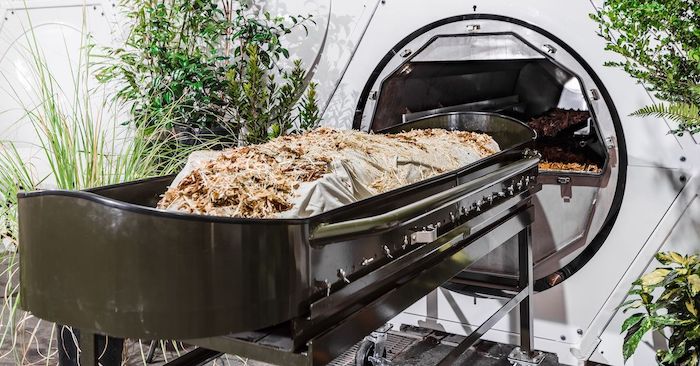
By Sophie Hirsh
Human composting, an eco-friendly alternative to traditional burial, has already been made legal in Colorado, Oregon, Vermont, and Washington. Plus, states including California, Illinois, Massachusetts, and New York have introduced legislation to legalize the process. So as the carbon neutral burial process grows in legality across the nation, more and more human composting facilities and funeral homes are springing up.
Thinking about your end of life can be scary — and made even scarier when considering the high environmental impacts of traditional death practices such as burial and cremation.
So if you are interested in learning more about human composting and your body returning to the earth when you leave this planet, keep reading for a look into a few of the innovative funeral homes leading the way in human composting, aka natural organic reduction.
Recompose is leading the way for human composting in the U.S..

Source: SABEL ROIZEN Recompose’s human composting vessel.
Recompose, which is based in Kent, Wash., is a full-service funeral home that works directly with clients and families for empathetic end-of-life processes. After a client passes away, for 30 days, the Recompose team regularly mixes the body with soil, alfalfa, woodchips, and straw in a Recompose vessel.
Once the body has fully turned into soil, they remove any items that did not break down, such as dental fillings or metal pins and screws, and recycle them; the soil is then moved to a bin for several more weeks to cure and dry. Recompose will then offer some topsoil to the person’s loved ones; otherwise, it will be donated to a conservation partner.
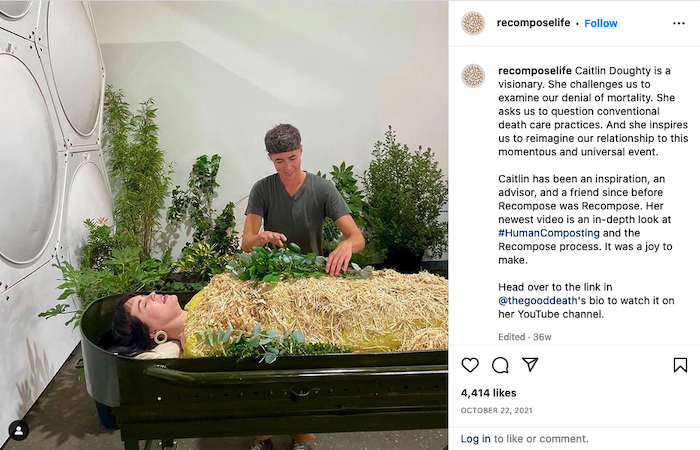
Recompose’s full-service burial (including local transportation of the body, the entire natural organic reduction process, death certificate filing, an online obituary, and more) costs $7,000. The company’s services are open to people anywhere; but you’ll be responsible for paying to transport the body to Washington.
Not only was Recompose the first licensed human composting funeral home to open in the U.S., but Recompose and its founder Katrina Spade actually inspired a Washington bill to legalize the process in the state back in 2019. Additionally, the Recompose team is also helping pave the way for other states to legalize human composting, which you can learn more about on the public policy section of Recompose’s website. The company is also planning to open a second location by the end of 2022, in Colorado.
Return Home offers human composting in Washington and nationwide.
View this post on Instagram
Return Home, which opened in 2021, offers “inclusive, gentle, transparent death care” via its Terramation human composting process. The company’s facility is based in Auburn, Wash., but offers its services to people across all 50 states and Canada.
At Return Home, deceased bodies are placed in a vessel. For 30 days, oxygen is flowed through to stimulate microbes in the body, which turns it to soil; then for the following 30 days, the soil rests and stabilizes. During these 60 days, visitors can come visit their deceased loved one in their vessel at Return Home’s facility turning business hours. At the end of the process, the deceased’s family can take the soil, or opt to have it scattered in nature.
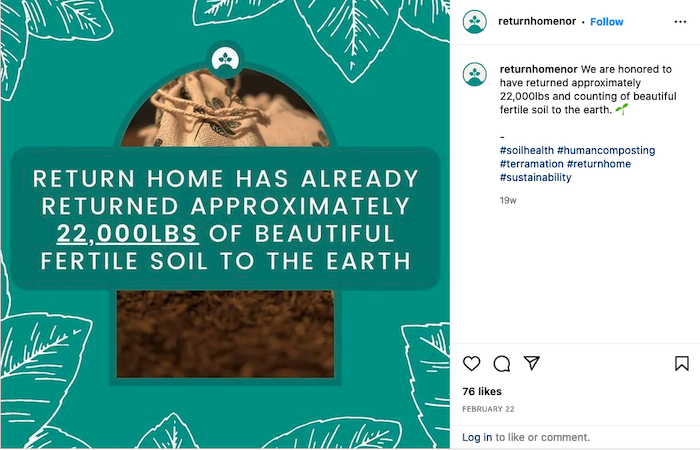
Return Home’s full-service process costs $4,950. The company allows people to plan ahead to arrange their eco-friendly burials; it also offers services to those with an immediate need, and keeps its phone lines open 24/7 for this purpose.
Return Home is passionate about legalizing human composting more widely, and the company created the #IdRatherBeCompost campaign to help lead this movement. You can find a letter-writing template on Return Home’s website, which you can use to encourage your elected officials to support legalizing natural organic reduction in your state.
Earth offers natural organic reduction in Washington and Oregon.
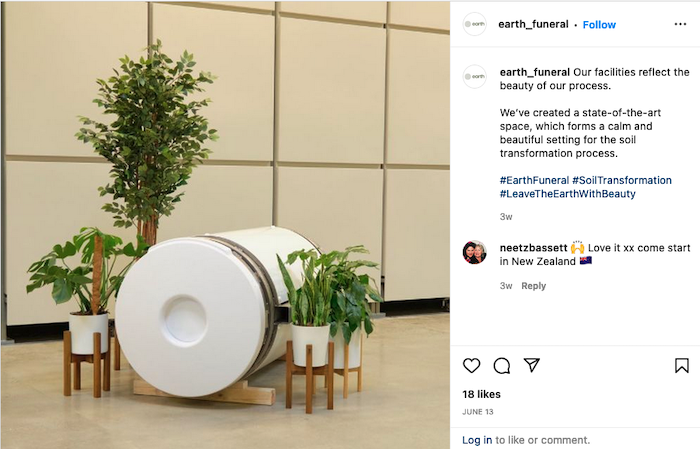
“Funeral brand” Earth describes offers burial via a 45-day process called soil transformation. Earth uses its proprietary vessel technology; a balance of carbon, nitrogen, oxygen, and water; materials like mulch, wildflowers, and woodchips; and ideal moisture and temperature levels to create the optimized conditions for microbes and bacteria to break down the body, much like it would in nature.
At the end of the process, the deceased’s family choose to plant or scatter some of the resulting soil; the remaining soil is used for land restoration projects on the company’s conservation site in Washington’s Olympic Peninsula.
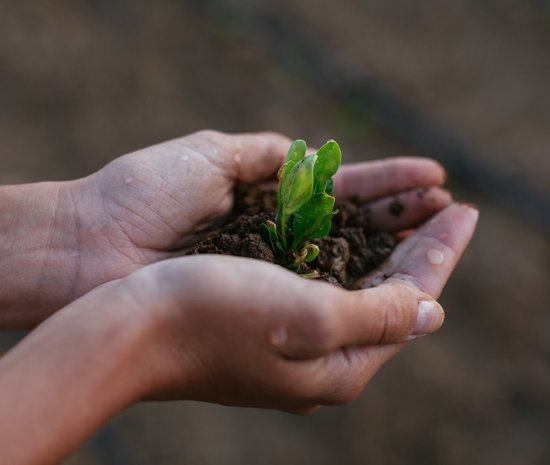
Earth has two facilities, located in Portland, Ore. and Auburn, Wash., both of which are powered by renewable electric energy. Currently, the company is only offering its services to those based in the Pacific Northwest (more details can be found here). Even though transporting dead bodies is legal, Earth believes “doing so undermines one of the greatest advantages of soil transformation, which is that the process is carbon neutral.”
Earth’s soil transformation package — which includes funeral services, all paperwork, and more — typically costs between $5,000 and $6,000.
Complete Article ↪HERE↩!
